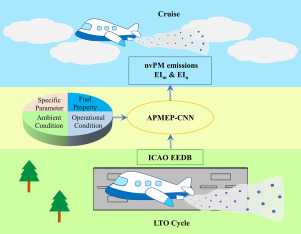
Newly Uncovered “Onion-Like” Nanoparticles in Aircraft Exhaust May Transform Insights into Aviation Emissions
A collective of global scientists has unveiled previously unrecognized nanoparticles within jet engine exhaust that could significantly impact environmental science and public health. As per a pioneering study published in ACS ES&T Air on April 8, researchers uncovered four unique particle types—among them, unprecedented “onion-like” formations—through a comprehensive examination of aircraft emissions.
These newly detected particles display distinctive physical characteristics and seem to arise mainly from lubricating oils rather than standard combustion processes, thereby unlocking a new dimension in our perception of aviation’s environmental impact.
Revealing the Nanoparticles: Beyond Just Soot
For years, atmospheric experts have recognized soot as the primary element of aircraft engine particulate emissions. These soot particles, noted for their chaotic, “grape-like” clustering of ultrafine carbon, have documented repercussions for both climate and health.
Nevertheless, recent research questions this established notion. Utilizing high-resolution transmission electron microscopy to study actual aircraft emissions at Zurich Airport in Switzerland, scientists found four distinct particle categories within the exhaust streams:
1. Turbostratic (soot) particles – the conventional type of carbonaceous particles featuring disorganized graphitic layers.
2. Onion-like particles – round nanostructures with orderly, concentric carbon layering.
3. Amorphous particles – showing no specific shape or internal structure.
4. Trace amorphous particles – even tinier and less structurally defined than other amorphous types.
Notably, over 99% of these new particles were detected 15 meters downstream from the engine exit, suggesting an active transformation of emissions shortly after leaving the turbine.
What Are Onion-Like Particles?
Among the most captivating of the new findings were the “onion-like” particles—circular carbon nanostructures measuring just 10–20 nanometers in diameter. These tiny entities bear resemblance to lab-designed nanomaterials typically created for high-tech applications such as supercapacitors, lubricants, and biomedical fields.
Differing from soot clusters, onion-like particles generally exist as individual spheres. Their smooth, layered carbon shells may grant them enhanced chemical stability, modify their reactions with atmospheric compounds, or even affect their optical and heat-absorbing capabilities.
Perhaps most importantly, these particles do not seem to originate from jet fuel combustion. Rather, researchers associate their formation with the evaporation and condensation of lubricating oil additives utilized in aircraft engines, pointing to a separate origin route from conventionally studied pollutants.
Implications for Human Health
The public health ramifications of these discoveries are significant and require further scrutiny. Due to their ultrafine dimensions, these particles can circumvent the body’s natural filtration systems and settle deep within the respiratory system. Once there, their unique physical and chemical characteristics might provoke different biological reactions than typical soot.
“Considering their minuscule size and structured surfaces, onion-like nanoparticles could traverse lung tissue differently or potentially enter the bloodstream,” the scientists remarked. “Their interaction with biological systems is anticipated to differ from more well-known combustion-generated particles.”
Millions of individuals reside near major airports, and crews, ground personnel, and frequent flyers face ongoing exposure, heightening concerns regarding these newly identified emissions.
Environmental and Climate Implications
The newly discovered particles may also behave differently in the atmosphere compared to standard soot. Their streamlined formations and stable chemical properties could alter their interactions with atmospheric moisture, UV radiation, or greenhouse gases. These attributes, in turn, could affect their atmospheric lifespan and their potential to influence cloud formation or absorb heat—a crucial element in climate modeling.
The revelation that these primary exhaust particles stem from engine lubricant remnants rather than fuel combustion might necessitate a reevaluation of global approaches to regulating and mitigating aviation emissions.
Scientific Exploration Meets Technological Advancement
Curiously, the “onion-like” nanoparticles closely resemble intentionally engineered nanostructures developed in laboratories for specific industrial applications. Typically, producing such structures demands high temperatures and energy-intensive methods, often derived from soot or fullerene precursors.
“The natural creation of these particles in jet exhaust points to an extraordinary process at work, potentially offering insights into new, cost-effective nanomaterial synthesis techniques,” stated lead author Akihiro Fushimi of Japan’s National Institute for Environmental Studies.
A Connection to Previous Findings
This research builds upon earlier findings from 2019 by the same team, which indicated that non-soot particles originating from aircraft engine lubricating oils comprise a significant share of aviation-related nanoparticles. That earlier study shifted the focus toward components traditionally regarded as minor, and this latest publication adds structural validation and environmental context to that discovery.
Continuing Research and Future Pathways
While this discovery enriches our understanding, it also prompts critical new inquiries: • How do these particles chemically alter as they disperse in the atmosphere? • What are their health impacts compared to